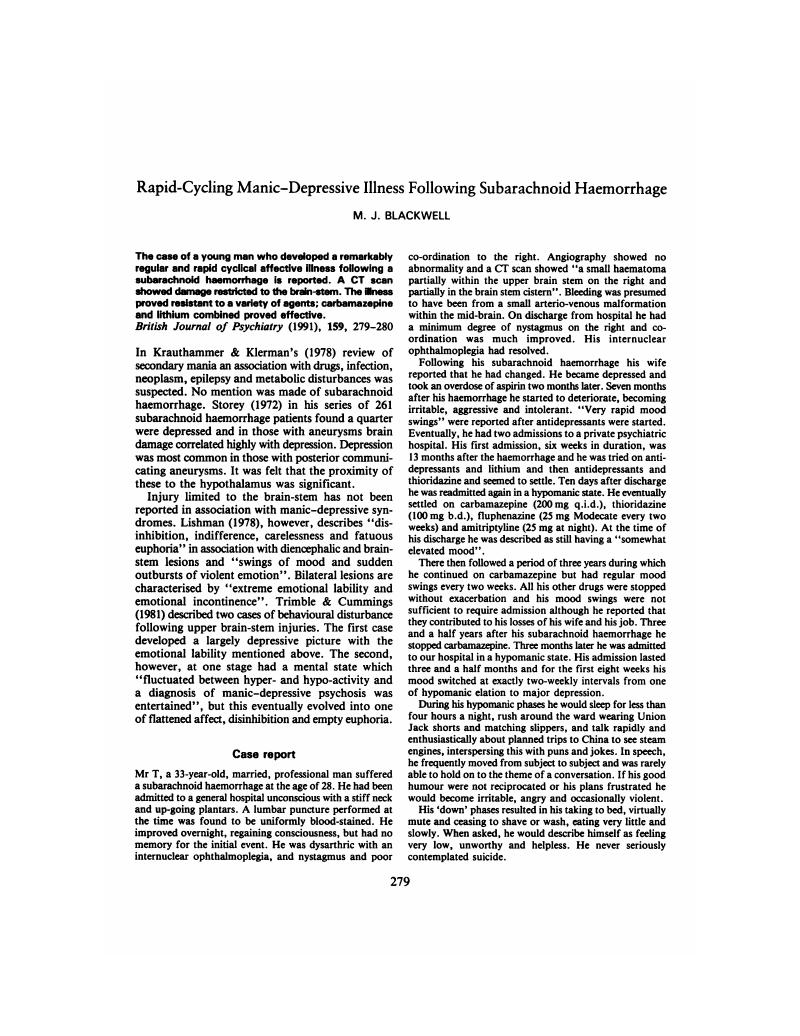Crossref Citations
This article has been cited by the following publications. This list is generated based on data provided by Crossref.
1993.
Secondary mania following traumatic brain injury.
American Journal of Psychiatry,
Vol. 150,
Issue. 6,
p.
916.
El‐Shazly, M.
1994.
Rapid cycling bipolar disorder in a case of Binswanger's disease.
International Journal of Geriatric Psychiatry,
Vol. 9,
Issue. 11,
p.
925.
Kulisevsky, Jaime
Avila, Asunción
and
Berthier, Marcelo L.
1995.
Bipolar affective disorder and unilateral parkinsonism after a brainstem infarction.
Movement Disorders,
Vol. 10,
Issue. 6,
p.
799.
Cooney, Golm
and
Lawlor, Brian A
1995.
Rapid cycling mania post head injury.
Irish Journal of Psychological Medicine,
Vol. 12,
Issue. 4,
p.
150.
Persad, E
Oluboka, Oj
Sharma, V
Mazmanian, D
and
Kueneman, K
1996.
The Phenomenon of Rapid Cycling in Bipolar Mood Disorders: A Review.
The Canadian Journal of Psychiatry,
Vol. 41,
Issue. 1,
p.
23.
1996.
Poststroke bipolar affective disorder: clinical subtypes, concurrent movement disorders, and anatomical correlates.
The Journal of Neuropsychiatry and Clinical Neurosciences,
Vol. 8,
Issue. 2,
p.
160.
Camus, Vincent
de Mendonça Lima, Carlos Augusto
Antonioli, Daniel
and
Wertheimer, Jean
1997.
Rapid-Cycling Affective Disorder in the Elderly: Clinical Subtype or Specific Course of Manic-Depressive Illness?.
Journal of Geriatric Psychiatry and Neurology,
Vol. 10,
Issue. 3,
p.
105.
Vanstraelen, M.
and
Tyrer, S. P.
1999.
Review: Rapid cycling bipolar affective disorder in people with intellectual disability: a systematic review.
Journal of Intellectual Disability Research,
Vol. 43,
Issue. 5,
p.
349.
Calabrese, Joseph R.
Rapport, Daniel J.
Findling, Robert L.
Shelton, Melvin D.
and
Kimmel, Susan E.
2000.
Bipolar Disorders.
p.
89.
Mackin, Paul
and
Young, Allan H
2004.
Rapid cycling bipolar disorder: historical overview and focus on emerging treatments.
Bipolar Disorders,
Vol. 6,
Issue. 6,
p.
523.
Elhaj, Omar
and
Calabrese, Joseph R.
2005.
Bipolar Disorders.
p.
61.
Bauer, Michael
Beaulieu, Serge
Dunner, David L
Lafer, Beny
and
Kupka, Ralph
2008.
Rapid cycling bipolar disorder – diagnostic concepts.
Bipolar Disorders,
Vol. 10,
Issue. 1p2,
p.
153.
Santos, Catarina O.
Caeiro, Lara
and
Ferro, José M.
2013.
Neuropsychiatric Symptoms of Cerebrovascular Diseases.
p.
65.
Fountoulakis, Kostas N.
2015.
Bipolar Disorder.
p.
81.
D’aes, Tine
and
Mariën, Peter
2015.
Cognitive and Affective Disturbances Following Focal Brainstem Lesions: A Review and Report of Three Cases.
The Cerebellum,
Vol. 14,
Issue. 3,
p.
317.
Kutlubaev, M. A.
2016.
Poststroke mania.
Zhurnal nevrologii i psikhiatrii im. S.S. Korsakova,
Vol. 116,
Issue. 12. Vyp. 2,
p.
21.




eLetters
No eLetters have been published for this article.